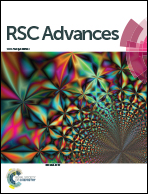Locked nucleic acid modified bi-specific aptamer-targeted nanoparticles carrying survivin antagonist towards effective colon cancer therapy†
Abstract
We investigated the anti-cancer activity of alginate coated chitosan nanoparticles (CHNP) encapsulating cell-permeable dominant negative survivin (SR9) with locked nucleic acid (LNA) aptamers targeting EpCAM and nucleolin (termed as “nanobullets”) in vitro (2D and 3D cell culture models) and in vivo (colon cancer mouse xenograft model). We incorporated three LNA modifications in each sequence in order to enhance the stability of these aptamers. Confocal microscopy revealed binding of the LNA-aptamers to their specific markers with high affinity. The muco-adhesive nanobullets showed 6-fold higher internalization in cancer cells when compared to non-cancerous cells, suggesting a tumour specific uptake. A higher intensity of nanobullets was observed in both the periphery and the core of the multicellular tumour spheroids compared to non-targeted CHNP-SR9. The nanobullets were found to be the highly effective as they led to a 2.26 fold (p < 0.05) reduction at 24 h and a 4.95 fold reduction (p ≤ 0.001) in the spheroid size at 72 h. The tumour regression was 4 fold higher in mice fed on a nanobullet diet when compared to a control diet. The nanobullets were able to show a significantly high apoptotic (p ≤ 0.0005) and necrotic index in the tumour cell population (p ≤ 0.005) when compared to void NPs. Therefore, our nanoparticles have shown highly promising results and therefore deliver a new conduit towards the approach of cancer-targeted nanodelivery.


 Please wait while we load your content...
Please wait while we load your content...